Fintech
Gold Fund Holdings Update – October 2022 and Attribution Analysis
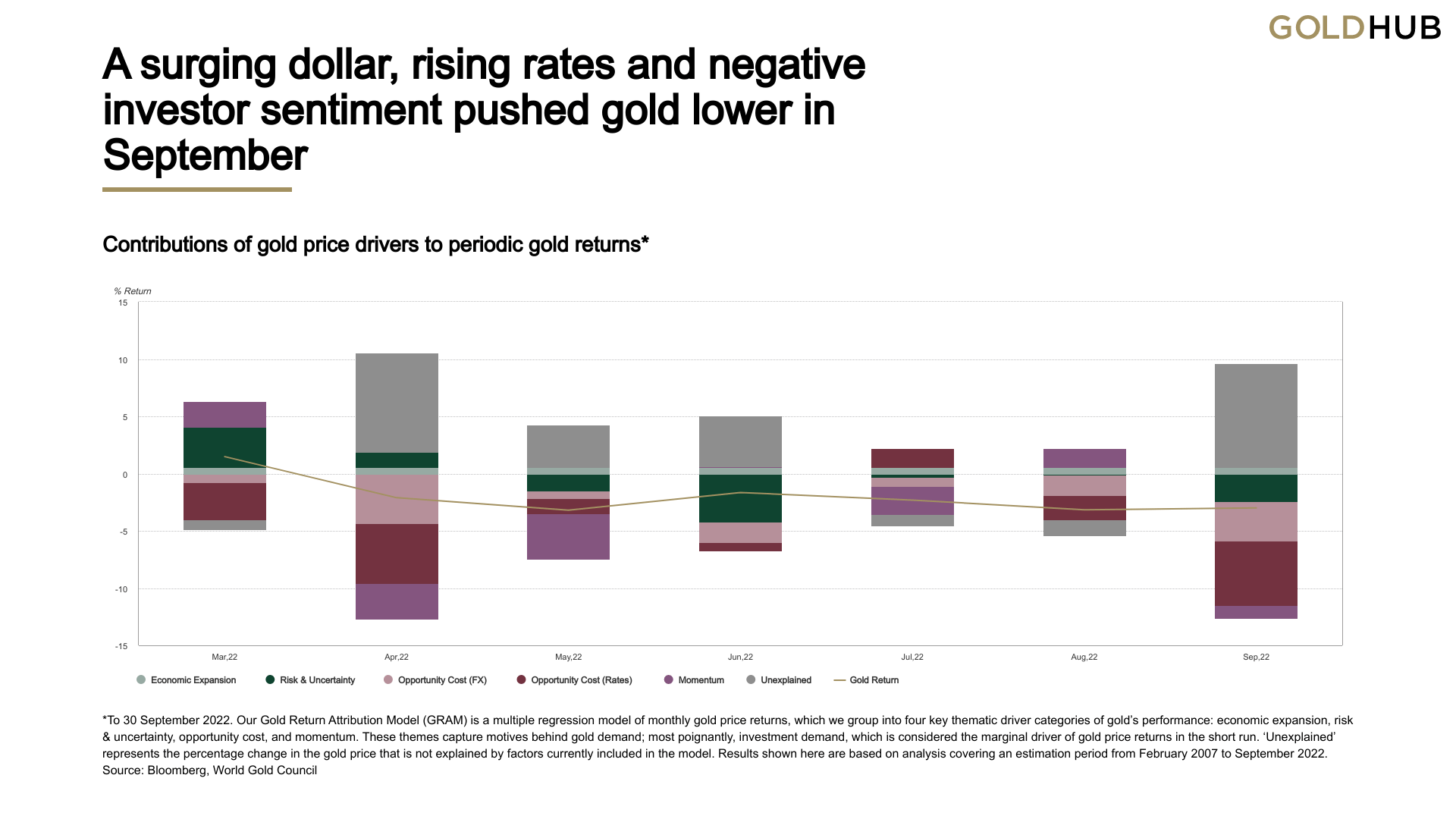
Toronto, Ontario–(Newsfile Corp. – October 26, 2022) – This report details the most recent portfolio holdings for Precious Metal Managed Funds and summarizes changes in portfolio holdings.
A Copy of the Full Report is Available at the Link Below:
https://mailchi.mp/mineralfunds/portfolio-holdings-update-october-2022
Gold & Precious Metal Funds included in this report:
A portfolio holding ‘attribution analysis‘ is undertaken on the portfolios of gold funds that report asset allocations monthly, and on any fund with assets in excess of $1 Billion USD reporting during the period.
The analysis includes a list of companies which are new to a portfolio in the period ‘New Company Holdings’, and companies which have been eliminated from a portfolio during the period ‘Companies Divested’. ‘Increasing Shareholding’ and ‘Decreasing Shareholding’ fields identify companies to which a fund is either increasing or, alternatively, decreasing exposure.
FUNDS REPORTING MONTHLY
Fidelity Select Gold Portfolio
| 31.Aug.2022 | $1,186 M USD |
| New Company Holdings | Companies Divested |
| Osisko Development Corp. | Gold Standard Ventures Corp. |
| Largest Position: | |
| Newmont Corp. (NYSE: NEM) | 11.3% |
Franklin Gold & Precious Metals Fund (USA) Franklin Gold & Precious Metals Fund (Lux)
| 30.Sept.2022 | $839 M USD | 30.Sept.2022 | $334 M USD |
| New Company Holdings | Companies Divested | New Company Holdings | Companies Divested |
| Leo Lithium Ltd. | Goulamina Holdings Pty. Ltd. | Leo Lithium Ltd. | Goulamina Holdings Pty. Ltd. |
| Largest Position: | Largest Position: | ||
| Endeavor Mining (TSX: EDV) | 5.5% | Endeavor Mining (TSX: EDV) | 5.7% |
| Increasing Shareholding | Decreasing Shareholding | Increasing Shareholding | Decreasing Shareholding |
| Marathon Gold Corp. | Argonaut Gold Inc. | Anglo American Platinum Ltd. | Barrick Gold Corp. |
| Pantoro Ltd. | Barrick Gold Corp. | Benchmark Metals Inc. | Endeavour Mining Plc. |
| Skeena Resources Ltd. | Eastern Platinum Ltd. | Centamin Plc. | Ivanhoe Mines Ltd. |
| Endeavour Mining Plc. | Impala Platinum Holdings Ltd. | ||
| Ivanhoe Mines Ltd. | Lion One Metals Ltd. | ||
| St. Augustine Gold & Copper Ltd. | Marathon Gold Corp. | ||
| Newmont Corp. | |||
| Pantoro Ltd. | |||
| Skeena Resources Ltd. | |||
| SSR Mining Inc. |
VanEck International Investors Gold Fund VanEck VIP Global Gold Fund
| 30.Sept.2022 | $611 M USD | 30.Sept.2022 | $39 M USD |
| New Company Holdings | Companies Divested | New Company Holdings | Companies Divested |
| None | Wallbridge Mining Co. Ltd. | None | Wallbridge Mining Co. Ltd. |
| Largest Position: | Largest Position: | ||
| Franco-Nevada Crp. (TSX: FNV) | 9.5% | Franco-Nevada Crp. (TSX: FNV) | 9.2% |
| Increasing Shareholding | Decreasing Shareholding | Increasing Shareholding | Decreasing Shareholding |
| Alamos Gold Inc. | Franco-Nevada Corporation | Alamos Gold Inc. | Newmont Corp. |
| Marathon Gold Corp. | Agnico Eagle Mines Limited | Marathon Gold Corp. | West African Resources Ltd. |
| Galway Metals, Inc. | Endeavour Mining PLC | Galway Metals, Inc. | |
| Barrick Gold Corp. | Equinox Gold Corp. | ||
| Newmont Corp. | Bonterra Resources, Inc. | ||
| Kinross Gold Corp. | Bear Creek Mining Corp. | ||
| Wheaton Precious Metals Corp. | Nighthawk Gold Corp. | ||
| B2Gold Corp. | Perpetua Resources Corp. | ||
| Yamana Gold Inc. | |||
| Northern Star Resources Ltd. | |||
| West African Resources Ltd. | |||
| SSR Mining Inc. | |||
| Royal Gold, Inc. | |||
| Osisko Gold Royalties Ltd. | |||
| Evolution Mining Ltd. | |||
| Gold Fields Ltd. | |||
| Eldorado Gold Corp. | |||
| Equinox Gold Corp. | |||
| Bonterra Resources, Inc. | |||
| Bear Creek Mining Corp. | |||
| Nighthawk Gold Corp. | |||
| Perpetua Resources Corp. |
FUNDS REPORTING MONTHLY ATTRIBUTION ANALYSIS
AUM in all monthly reporting gold funds decreased through August and September respectively.
Fidelity Select Gold Portfolio
AUM for Fidelity Gold Fund decreased in August from $1,325 M USD to $1,186 M USD (-10.5%).
The Fund took on a new position in Osisko Development Corporation (TSXV: ODV). Osisko Development is a relatively new company, managed and developed by the Osisko Management Group, which is focusing on 3 principal development projects: The Cariboo Gold Project (high-grade gold in British Columbia, Canada), The Tintic Gold Project (high-grade gold in central Utah, USA) and The San Antonio Gold-Copper Project (gold and copper development in Sonora State, Mexico).
At current share prices, Osisko Development (TSXV: ODV) is trading at a market capitalisation of ~ $375M and at approximately ~25% of the October 2020 RTO (Reverse Takeover) share price. The company consolidated shares outstanding on a 3:1 basis in May of 2022. In October of 2020, the company raised more than $80 M CAD at an RTO (Reverse Takeover) price of approximately $22.50 per share (split-adjusted). During August of 2022, when Fidelity Select Gold Portfolio first initiated a new position, Osisko Development (TSXV: ODV) traded as low as $5.25 per share. This was the lowest share price for (TSXV: ODV) since the company began trading with a new precious metal development mandate in October 2022, and represents a ~75% discount to the company’s RTO price.
Orla Mining Ltd. (TSX: OLA) completed acquisition of Gold Standard Ventures Corp. on August 12th resulting in the elimination of Gold Standard from the portfolio, and the continuation of a new position in Orla Mining Ltd. (TSX: OLA).
Franklin Gold & Precious Metals Fund (USA)
AUM for Franklin Gold and Precious Metals Fund (USA) decreased in September from $903 M USD to $839 M USD (-7.1%).
The Fund took up a new position in Australian listed Leo Lithium Ltd. (ASX: LLL) by conversion of Goulamina Holdings Pty. Ltd. Leo Lithium Ltd. (ASX: LLL) is developing the world class Goulamina Lithium Project in Mali, West Africa. This will be West Africa’s first spodumene producer and will come online in 2024 to supply the booming lithium-ion battery industry.
During the month of September, the Fund increased holdings in: Newfoundland developer Marathon Gold Corp. (TSX: MOZ) (pursuant to a financing), Australian listed gold developer Pantoro Ltd. (ASX: PNR) and BC developer Skeena Resources Ltd. (TSX: SKE) while reducing positioning in 6 out of 118 company holdings.
Franklin Gold & Precious Metals Fund (Lux) increased exposure to 10 of 122 companies held in the portfolio during September of 2022.
VanEck International Investors Gold Fund
AUM for VanEck International Investors Gold Fund remained unchanged in September at $687 M USD (0% change).
The Fund divested from Wallbridge Mining Company Ltd. (TSX: WM). On September 12th Wallbridge had announced the commissioning of an update to the 2021 mineral resource estimate for its flagship Fenelon Gold and Martiniere Project.
Pursuant to a private placement financing, the Fund increased its positioning in Marathon Gold Corp. (TSX: MOZ). As a result of open market purchases, the Fund increased its positioning in Alamos Gold Inc. (TSX: AGI) and Galway Metals Inc. (TSXV: GWM). The Fund reduced positioning in 21 of 51 holdings.
VanEck VIP Global Gold Fund
AUM for VanEck VIP Global Gold Fund remained unchanged in September at $39 M USD (0% change).
The Fund did not add any new positions but divested from Wallbridge Mining Company Ltd. (TSX: WM). The Fund participated in the financing for Marathon Gold Corp. (TSX: MOZ) and increased positioning in Alamos Gold Inc. (TSX: AGI).
FUND > $1 Billion USD
A portfolio holding ‘attribution analysis‘ is undertaken on the portfolios of gold funds that report asset allocations monthly, and on any fund with assets in excess of $1 Billion USD reporting during the period.
Invesco Gold and Special Minerals Fund (USA) Fund Reports Quarterly
Fund Comparison: July 31st 2022 / April 30th 2022
| 31.Jul.2022 | $1,771 M USD |
| New Company Holdings | Companies Divested |
| Capricorn Metals Ltd. | Lake Resources NL |
| Yamana Gold, Inc. | |
| Americas Gold & Silver Corp. | |
| Ascot Resources Ltd. | |
| Barrick Gold Corp. | |
| Canada Nickel Co., Inc. | |
| Foran Mining Corp. | |
| Prime Mining Corp. | |
| Wallbridge Mining Co. Ltd. | |
| Zhaojin Mining Industry Co. Ltd. | |
| Argonaut Gold, Inc. | |
| MP Materials Corp. | |
| Largest Position: | |
| Newmont Corp. (NYSE: NEM) | 12.0% |
| Increasing Shareholding | Decreasing Shareholding |
| Aeris Resources Ltd. | Allkem Ltd. |
| Centaurus Metals Ltd. | Evolution Mining Ltd. |
| Chalice Mining Ltd. | Firefinch Ltd. |
| De Grey Mining Ltd. | Gold Road Resources Ltd. |
| Predictive Discovery Ltd. | Lynas Rare Earths Ltd. |
| Red 5 Ltd. | Newcrest Mining Ltd. |
| Rumble Resources Ltd. | Northern Star Resources Ltd. |
| Liberty Gold Corp. | OceanaGold Corp. |
| Marathon Gold Corp. | Pantoro Ltd. |
| Osino Resources Corp. | Perseus Mining Ltd. |
| Pure Gold Mining, Inc. | Pilbara Minerals Ltd. |
| Rupert Resources Ltd. | Silver Lake Resources Ltd. |
| Sierra Metals, Inc. | Tietto Minerals Ltd. |
| Skeena Resources Ltd. | Wheaton Precious Metals Corp. |
| Solaris Resources, Inc. | Agnico Eagle Mines Ltd. |
| Tudor Gold Corp. | Alamos Gold, Inc. |
| Meridian Mining UK Societas | Arizona Metals Corp. |
| Coeur Mining, Inc. | Artemis Gold, Inc. |
| Calibre Mining Corp. | |
| Centerra Gold, Inc. | |
| Filo Mining Corp. | |
| Franco-Nevada Corp. | |
| Hudbay Minerals, Inc. | |
| i-80 Gold Corp. | |
| Ivanhoe Mines Ltd. | |
| Karora Resources, Inc. | |
| Kinross Gold Corp. | |
| Lithium Americas Corp. | |
| MAG Silver Corp. | |
| Minera Alamos, Inc. | |
| New Gold, Inc. | |
| Orla Mining Ltd. | |
| Osisko Gold Royalties Ltd. | |
| SilverCrest Metals, Inc. | |
| Triple Flag Precious Metals Corp. | |
| Victoria Gold Corp. | |
| Ganfeng Lithium Co. Ltd. | |
| Zijin Mining Group Co. Ltd. | |
| GCM Mining Corp. | |
| Nickel Mines Ltd. | |
| Gold Fields Ltd. | |
| Sibanye Stillwater Ltd. | |
| Eldorado Gold Corp. | |
| Century Aluminum Co. | |
| Freeport-McMoRan, Inc. | |
| Gatos Silver, Inc. | |
| Newmont Corp. | |
| Piedmont Lithium, Inc. | |
| Royal Gold, Inc. | |
| Tronox Holdings PLC | |
| First Quantum Minerals Ltd. |
Invesco Gold and Special Minerals Fund (USA)
AUM for Invesco Gold & Special Minerals Fund (USA) decreased over the quarter from: $2,377 M USD on 30th April 2022 to $1,771 M USD on 31st July 2022 (-25.5%).
The Fund’s largest holding remains Newmont Corp. (NYSE: NEM) at 12.0%.
The Fund acquired 12 new company names in a portfolio holding a total of 114 companies. New company names included juniors: Canada Nickel Corp. (TSXV: CNC) which is advancing the large-scale Crawford Nickel-Cobalt Sulphide Discovery in the Timmins Mining Camp, and Americas Gold and Silver Corporation (TSX: USA) which is operating three producing precious metals mines including the Relief Canyon Mine in Nevada.
The Fund decreased positioning in 51 of 114 holdings as market contraction and redemptions pressured the portfolio.
A complete list of Precious Metal Managed Funds and their respective portfolio holdings can be found at: https://mineralfunds.com/gold-funds/
Reported by: Khadijah Samnani, Analyst Supported By: Christopher Berlet BSc, CFA
For further information please contact:
(416) 525 – 6869
[email protected]
Fintech
How to identify authenticity in crypto influencer channels

Modern brands stake on influencer marketing, with 76% of users making a purchase after seeing a product on social media.The cryptocurrency industry is no exception to this trend. However, promoting crypto products through influencer marketing can be particularly challenging. Crypto influencers pose a significant risk to a brand’s reputation and ROI due to rampant scams. Approximately 80% of channels provide fake statistics, including followers counts and engagement metrics. Additionally, this niche is characterized by high CPMs, which can increase the risk of financial loss for brands.
In this article Nadia Bubennnikova, Head of agency Famesters, will explore the most important things to look for in crypto channels to find the perfect match for influencer marketing collaborations.
-
Comments
There are several levels related to this point.
LEVEL 1
Analyze approximately 10 of the channel’s latest videos, looking through the comments to ensure they are not purchased from dubious sources. For example, such comments as “Yes sir, great video!”; “Thanks!”; “Love you man!”; “Quality content”, and others most certainly are bot-generated and should be avoided.
Just to compare:

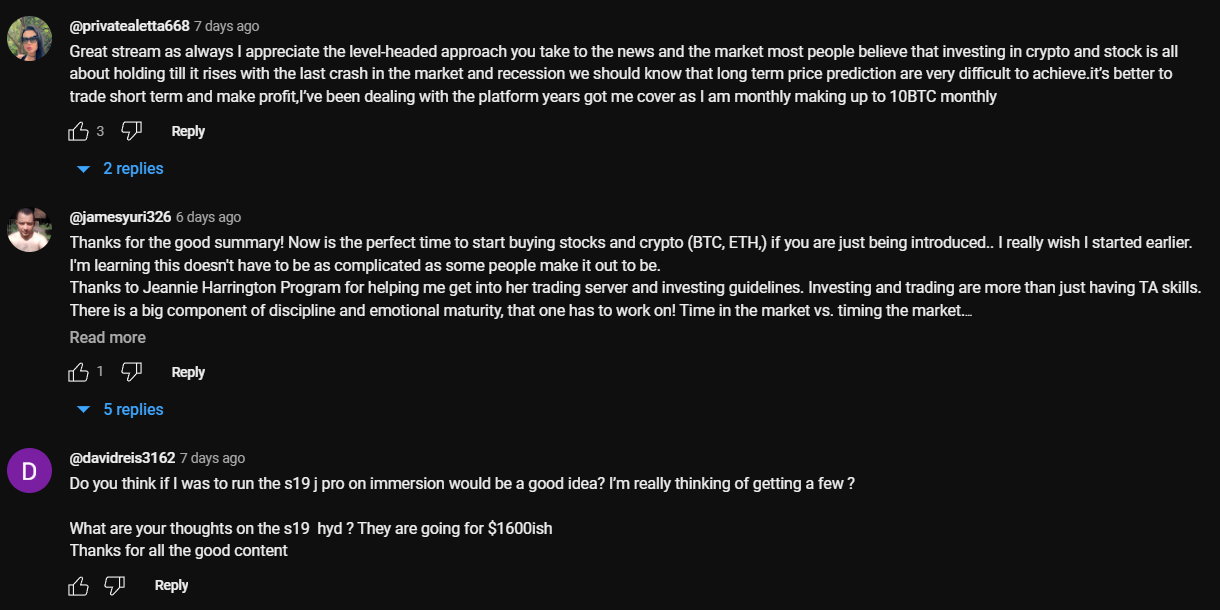
LEVEL 2
Don’t rush to conclude that you’ve discovered the perfect crypto channel just because you’ve come across some logical comments that align with the video’s topic. This may seem controversial, but it’s important to dive deeper. When you encounter a channel with logical comments, ensure that they are unique and not duplicated under the description box. Some creators are smarter than just buying comments from the first link that Google shows you when you search “buy YouTube comments”. They generate topics, provide multiple examples, or upload lists of examples, all produced by AI. You can either manually review the comments or use a script to parse all the YouTube comments into an Excel file. Then, add a formula to highlight any duplicates.

LEVEL 3
It is also a must to check the names of the profiles that leave the comments: most of the bot-generated comments are easy to track: they will all have the usernames made of random symbols and numbers, random first and last name combinations, “Habibi”, etc. No profile pictures on all comments is also a red flag.
LEVEL 4
Another important factor to consider when assessing comment authenticity is the posting date. If all the comments were posted on the same day, it’s likely that the traffic was purchased.
2. Average views number per video
This is indeed one of the key metrics to consider when selecting an influencer for collaboration, regardless of the product type. What specific factors should we focus on?
First & foremost: the views dynamics on the channel. The most desirable type of YouTube channel in terms of views is one that maintains stable viewership across all of its videos. This stability serves as proof of an active and loyal audience genuinely interested in the creator’s content, unlike channels where views vary significantly from one video to another.
Many unauthentic crypto channels not only buy YouTube comments but also invest in increasing video views to create the impression of stability. So, what exactly should we look at in terms of views? Firstly, calculate the average number of views based on the ten latest videos. Then, compare this figure to the views of the most recent videos posted within the past week. If you notice that these new videos have nearly the same number of views as those posted a month or two ago, it’s a clear red flag. Typically, a YouTube channel experiences lower views on new videos, with the number increasing organically each day as the audience engages with the content. If you see a video posted just three days ago already garnering 30k views, matching the total views of older videos, it’s a sign of fraudulent traffic purchased to create the illusion of view stability.
3. Influencer’s channel statistics
The primary statistics of interest are region and demographic split, and sometimes the device types of the viewers.
LEVEL 1
When reviewing the shared statistics, the first step is to request a video screencast instead of a simple screenshot. This is because it takes more time to organically edit a video than a screenshot, making it harder to manipulate the statistics. If the creator refuses, step two (if only screenshots are provided) is to download them and check the file’s properties on your computer. Look for details such as whether it was created with Adobe Photoshop or the color profile, typically Adobe RGB, to determine if the screenshot has been edited.
LEVEL 2
After confirming the authenticity of the stats screenshot, it’s crucial to analyze the data. For instance, if you’re examining a channel conducted in Spanish with all videos filmed in the same language, it would raise concerns to find a significant audience from countries like India or Turkey. This discrepancy, where the audience doesn’t align with regions known for speaking the language, is a red flag.
If we’re considering an English-language crypto channel, it typically suggests an international audience, as English’s global use for quality educational content on niche topics like crypto. However, certain considerations apply. For instance, if an English-speaking channel shows a significant percentage of Polish viewers (15% to 30%) without any mention of the Polish language, it could indicate fake followers and views. However, if the channel’s creator is Polish, occasionally posts videos in Polish alongside English, and receives Polish comments, it’s important not to rush to conclusions.
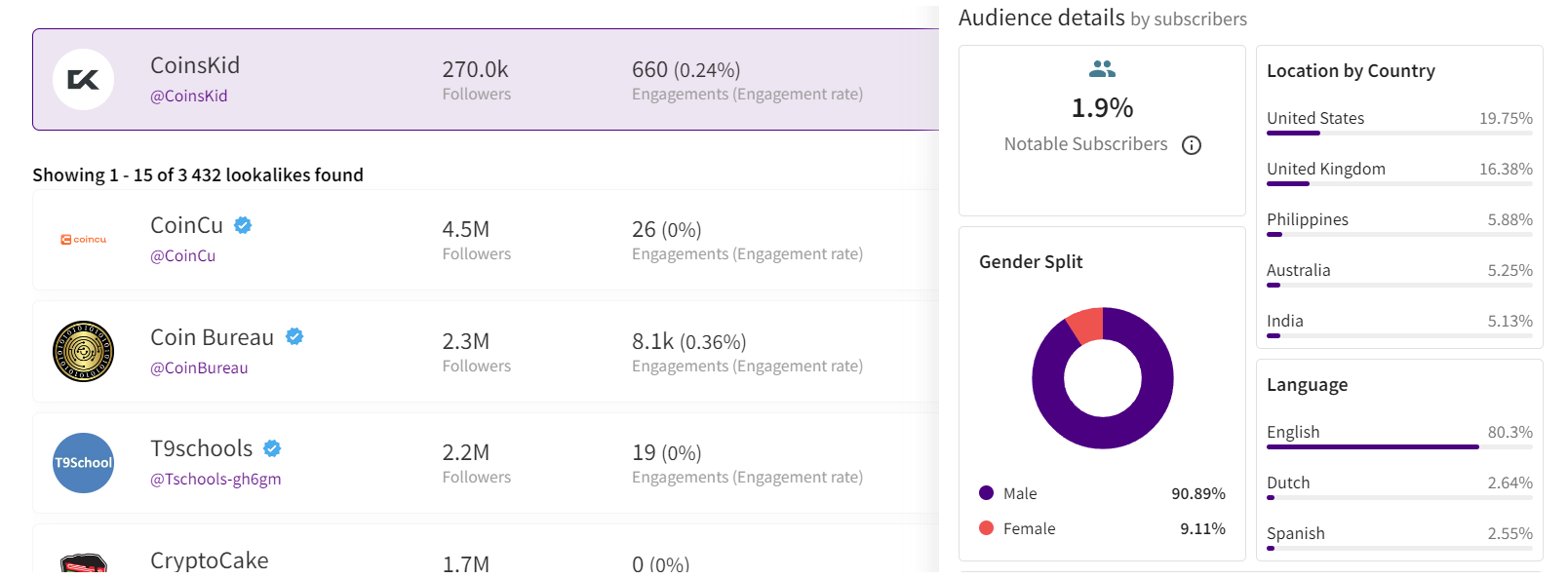 Example of statistics
Example of statistics
Wrapping up
These are the main factors to consider when selecting an influencer to promote your crypto product. Once you’ve launched the campaign, there are also some markers to show which creators did bring the authentic traffic and which used some tools to create the illusion of an active and engaged audience. While this may seem obvious, it’s still worth mentioning. After the video is posted, allow 5-7 days for it to accumulate a basic number of views, then check performance metrics such as views, clicks, click-through rate (CTR), signups, and conversion rate (CR) from clicks to signups.
If you overlooked some red flags when selecting crypto channels for your launch, you might find the following outcomes: channels with high views numbers and high CTRs, demonstrating the real interest of the audience, yet with remarkably low conversion rates. In the worst-case scenario, you might witness thousands of clicks resulting in zero to just a few signups. While this might suggest technical issues in other industries, in crypto campaigns it indicates that the creator engaged in the campaign not only bought fake views and comments but also link clicks. And this happens more often than you may realize.
Summing up, choosing the right crypto creator to promote your product is indeed a tricky job that requires a lot of resources to be put into the search process.

Author
Nadia Bubennikova, Head of agency at Famesters
Fintech
Central banks and the FinTech sector unite to change global payments space
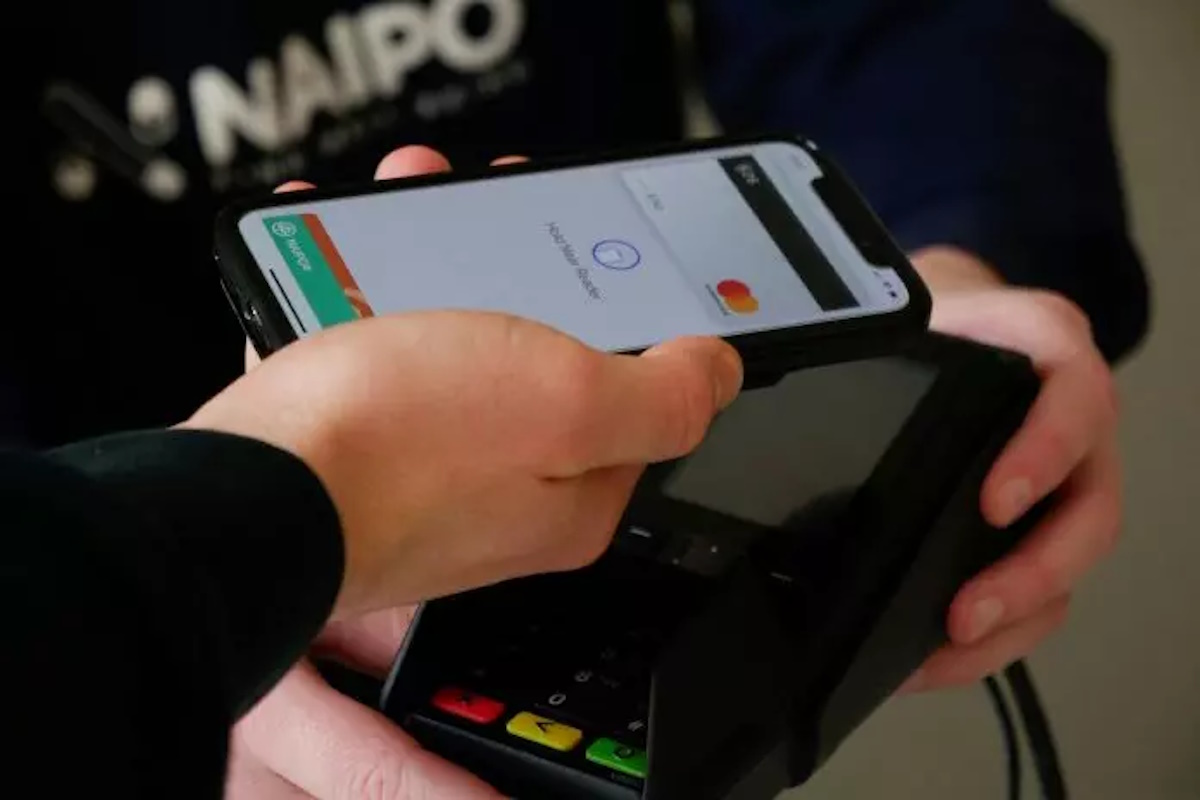
The BIS, along with seven leading central banks and a cohort of private financial firms, has embarked on an ambitious venture known as Project Agorá.
Named after the Greek word for “marketplace,” this initiative stands at the forefront of exploring the potential of tokenisation to significantly enhance the operational efficiency of the monetary system worldwide.
Central to this pioneering project are the Bank of France (on behalf of the Eurosystem), the Bank of Japan, the Bank of Korea, the Bank of Mexico, the Swiss National Bank, the Bank of England, and the Federal Reserve Bank of New York. These institutions have joined forces under the banner of Project Agorá, in partnership with an extensive assembly of private financial entities convened by the Institute of International Finance (IIF).
At the heart of Project Agorá is the pursuit of integrating tokenised commercial bank deposits with tokenised wholesale central bank money within a unified, public-private programmable financial platform. By harnessing the advanced capabilities of smart contracts and programmability, the project aspires to unlock new transactional possibilities that were previously infeasible or impractical, thereby fostering novel opportunities that could benefit businesses and consumers alike.
The collaborative effort seeks to address and surmount a variety of structural inefficiencies that currently plague cross-border payments. These challenges include disparate legal, regulatory, and technical standards; varying operating hours and time zones; and the heightened complexity associated with conducting financial integrity checks (such as anti-money laundering and customer verification procedures), which are often redundantly executed across multiple stages of a single transaction due to the involvement of several intermediaries.
As a beacon of experimental and exploratory projects, the BIS Innovation Hub is committed to delivering public goods to the global central banking community through initiatives like Project Agorá. In line with this mission, the BIS will soon issue a call for expressions of interest from private financial institutions eager to contribute to this ground-breaking project. The IIF will facilitate the involvement of private sector participants, extending an invitation to regulated financial institutions representing each of the seven aforementioned currencies to partake in this transformative endeavour.
Source: fintech.globa
The post Central banks and the FinTech sector unite to change global payments space appeared first on HIPTHER Alerts.
Fintech
TD Bank inks multi-year strategic partnership with Google Cloud
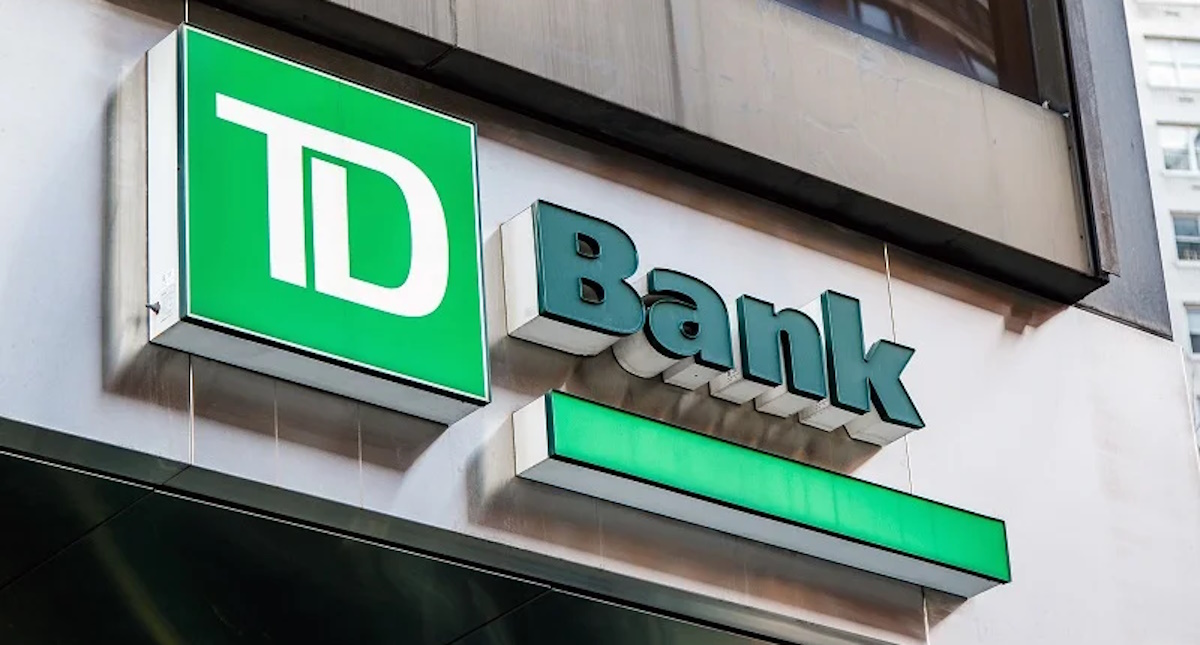
TD Bank has inked a multi-year deal with Google Cloud as it looks to streamline the development and deployment of new products and services.
The deal will see the Canadian banking group integrate the vendor’s cloud services into a wider portion of its technology solutions portfolio, a move which TD expects will enable it “to respond quickly to changing customer expectations by rolling out new features, updates, or entirely new financial products at an accelerated pace”.
This marks an expansion of the already established relationship between TD Bank and Google Cloud after the group previously adopted the vendor’s Google Kubernetes Engine (GKE) for TD Securities Automated Trading (TDSAT), the Chicago-based subsidiary of its investment banking unit, TD Securities.
TDSAT uses GKE for process automation and quantitative modelling across fixed income markets, resulting in the development of a “data-driven research platform” capable of processing large research workloads in trading.
Dan Bosman, SVP and CIO of TD Securities, claims the infrastructure has so far supported TDSAT with “compute-intensive quantitative analysis” while expanding the subsidiary’s “trading volumes and portfolio size”.
TD’s new partnership with Google Cloud will see the group attempt to replicate the same level of success across its entire portfolio.
Source: fintechfutures.com
The post TD Bank inks multi-year strategic partnership with Google Cloud appeared first on HIPTHER Alerts.
-
Latest News6 days ago
China remains stabilizing force for global economic growth
-
Latest News5 days ago
Kylian Mbappé and Accor Forge Alliance to Empower Younger Generations
-
Latest News3 days ago
Martello Re announces closing of $1.3 billion capital raise consisting of $935 million in equity and a $360 million upsize of the Company’s credit facility
-
Latest News4 days ago
BioCatch completes best first half in company history, grows ARR by 43% YoY
-
Latest News4 days ago
Market Dojo Celebrates Prestigious Inclusion in Ardent Partners 2024 Strategic Sourcing Technology Advisor
-
Latest News2 days ago
Driving Innovation Forward: CFI Welcomes Seven-Time Formula 1™ World Champion Lewis Hamilton as new Global Brand Ambassador
-
Latest News2 days ago
KEYSTONE BANK HOLDS CUSTOMER FORUM, REITERATES COMMITMENT TO EXCELLENT SERVICE DELIVERY
-
Latest News5 days ago
COP28 President calls on all stakeholders to bring spirit of solidarity that delivered UAE Consensus to drive implementation and sustainable socio-economic development




